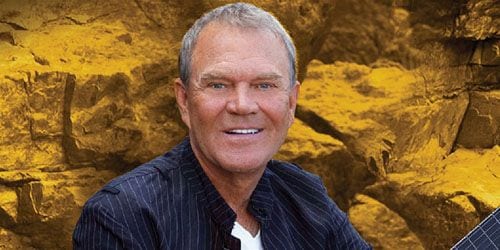
Back in 1977, the cynical response to the death of Elvis Presley was “good career move”. Indeed, sales of his products soared after his demise, as it has for many rock stars in his wake. Take a look at the recent boom triggered by the tragic passing of Amy Winehouse. Glen Campbell is still with us, but the semi-morbid publicity surrounding his latest release is geared towards increasing sales and attention to the artist.
Campbell has announced he has Alzheimer’s disease and that this will be has final record and last tour. This announcement has created a loud buzz and generated a wealth of stories in the music and mainstream press. Campbell is a legend, thanks to his work as a member of the Wrecking Crew, a group who played on Phil Spector’s wall-of-sound recordings, and later backing up such big name artists as Elvis Presley and Simon & Garfunkel. Plus, there is his career as a solo act. Campbell has several million sellers (e.g. “Wichita Lineman”, “Gentle on My Mind”, “Rhinestone Cowboy”) to his credit.
As an experienced pawer at thrift and pawn shop CD bins, I can attest to the fact that old Glen Campbell discs are frequently cheap finds. However, sales of this record, Ghost on the Canvas, have already zoomed into the top ten of Billboard‘s Country Album and Independent Album charts. Campbell has become a hot commodity again.
The theme of the album explicitly concerns the fact that Campbell has Alzheimer’s. This is announced in the lyrics of the very first cut, on the self-penned (with producer Julian Raymond) “A Better Place”. Campbell sings, “Some days I am so confused, Lord / The past gets in my way.” This succinct strophe conveys the perplexity of mental disorder in clear and simple manner. Sure it is schmaltzy, but…
Despite the crass marketing and sappy motif, this record deserves our attention. To make an analogy to the land of television (the place where Campbell first surged to fame, thanks to the Smothers Brothers Comedy Hour), a final episode to a last season can be anything from the banal mediocrity of what happened on Seinfeld to the ironic triumph of Newhart. Musicians do not always the same luxury of planning their end strategy as television writers, but Campbell and company do, and they make the most out of it.
First, Campbell enlisted the help of fellow musicians like Teddy Thompson, Paul Westerberg, Jakob Dylan, Roger Joseph Manning, Jr., and Robert Pollard to write songs for him. Then he hired talented side musicians like Billy Corgan, Dick Dale, Rick Nielsen, the Dandy Warhols, and Chris Isaak to perform with him. These are odd and dated choices. Why members of the Fleet Foxes and the National — two groups whose sound would seem a natural fit with this material — weren’t selected is unclear. But no matter. The musicians selected do an excellent job of giving a grand and spacious feel to the material that lets it breathe rather than feel entombed. One can whistle along to Campbell’s songs, despite the subject matter.
One of the ways in which the album keeps the music from getting maudlin are the six short minute-long instrumental interludes composed by Manning that occur at various moments across the album. They convey a formal beauty in their tossed off manner, like a wild rose growing in a ditch on a gravel road. From the sound of children playing atop a Randy Newman-like piano piece on “Valley of the Son” to the Tom Waits-like carnivalesque accordion-piano-string mixes on “May 21, 1969” to the Beach Boys-like harmonies on “The Rest Is Silence”, these sonic intermissions keep the moods changing.
Mostly, Campbell goes gentle into that good night. What else would one expect from a man who made songs like that of a Civil War soldier writing letters home to his girl (“Galveston”) and one in which a man leaves his lover for greener pastures (“By the Time I Get to Phoenix”) into soft rock hits? The closest Campbell gets to roaring is on Thompson’s rockabilly inflected “In My Arms”. But this is the rockabilly of a Buddy Holly or Roy Orbison more than that of a wild man like Jerry Lee Lewis, and offers the disquieting point that a person stricken with a mental disease (or any hurt) can always find comfort in the arms of love. There is more to life than just that.
Dylan’s “Nothing But the Whole Wide World” offers the strongest positive message, and Campbell does a great job of spiritually singing about what happens at the end of life. Simply put, when one dies and becomes “nothing”, the Lord connects us to everything — “the whole wide world”. The implications of this seem appropriately meaningful in this context.
Campbell has the last word. The album ends with a love song to his wife, “There is No Me…Without You”. It’s a tender ballad from a man whose many marriages and torrid affair with the much younger Tanya Tucker once made headlines. Now that the man has Alzheimer’s, he knows he has to depend more on those he loves. He expresses his appreciation for the love that others have shown him. That sounds like sane thinking to me.
